Making an IT policy template from scratch is hard work. Even if you get your in-house IT expert to write it for you, it’ll be a challenging task for them — unless they’re also a lawyer or have created similar policies in the past. Then there’s the second option — hire an outside consultant. This is a great alternative if you have money to spend.
Finally, we have the third option — and the best one for most businesses — and that’s using a pre-made IT policy template. In this article, we’ll tell you what IT policy templates are and why they’re used. We’ll also give you quality templates you can easily incorporate into your current IT administrative system.
What is an IT policy template?
An IT policy template helps you create a set of rules that tells your employees how they should handle information technology in your company. Different IT policy templates focus on different use cases. Let’s look at a Bring-Your-Own-Device IT policy as an illustration.

A Bring-Your-Own-Device (BYOD) policy gives the employee guidelines on how to use their personal device on the company’s network — like using a VPN, and regularly scanning for malware.
These regulations cover all processes employees should go through before bringing in their personal devices and security protocols to follow when in the office.
Why use an IT policy template?
An organization will need to release policies like the one we mentioned before throughout quarters and years. An IT policy template makes it easy to get the ball rolling, in addition to other benefits, including low cost, speed, and consistency. Let’s explore a few more here.
Avoid hefty consulting fees
Typically, creating an IT template for policies requires expertise and some financial investment. Most organizations either:
- Have in-house IT expert create them
- Have external IT consultant design them
In the latter case, you’d probably have to shell out a hefty amount to pay for the consultant. To save money, you can use a pre-made IT policy template. Just a word of caution, make sure that the template fits your IT needs. If it doesn’t, your IT team should modify the template accordingly.
Save time
Creating a policy from scratch is quite a burdensome task — especially for the person tasked with writing it. It can also be time-consuming to draft one.
Free templates can help you save time by serving as guidelines to inform your business’ IT policy. You can also reduce the time needed for approval or edits if a consistent format is used.
Follow tried and tested rules
When you create a policy from scratch, there’s a risk of leaving out an important guideline or requirement that could impact the company, its stakeholders, and its employees. On the other hand, when you use a quality template, you’re guaranteeing that important guidelines and rules will be included — since they’re based on tried and tested regulations.
What are some examples of IT policy templates?
Let’s look at the different types of IT policy templates:
Information security policy templates
An information security policy gives guidelines to employees on how to use IT assets and resources within a company. These guidelines apply to all users and data in an organization, preventing any security incidents from occurring.
Email policy template
An email policy template details clear guidelines on how employees should handle company emails. It provides clear-cut regulations for sending, receiving, and storing emails. This policy makes sure that employees use their company email in a way that aligns with company goals.
Clean desk policy template
A clean desk policy is a company rule that dictates how employees handle company information within the office. An employee’s desk should be left clean to prevent confidential data from falling into the wrong hands — this could be anything from passwords to candidate CVs.
This sample clean desk policy template covers things like unattended computers needing to be shut down or locked, safe storage of CDs and hard drives, and more.
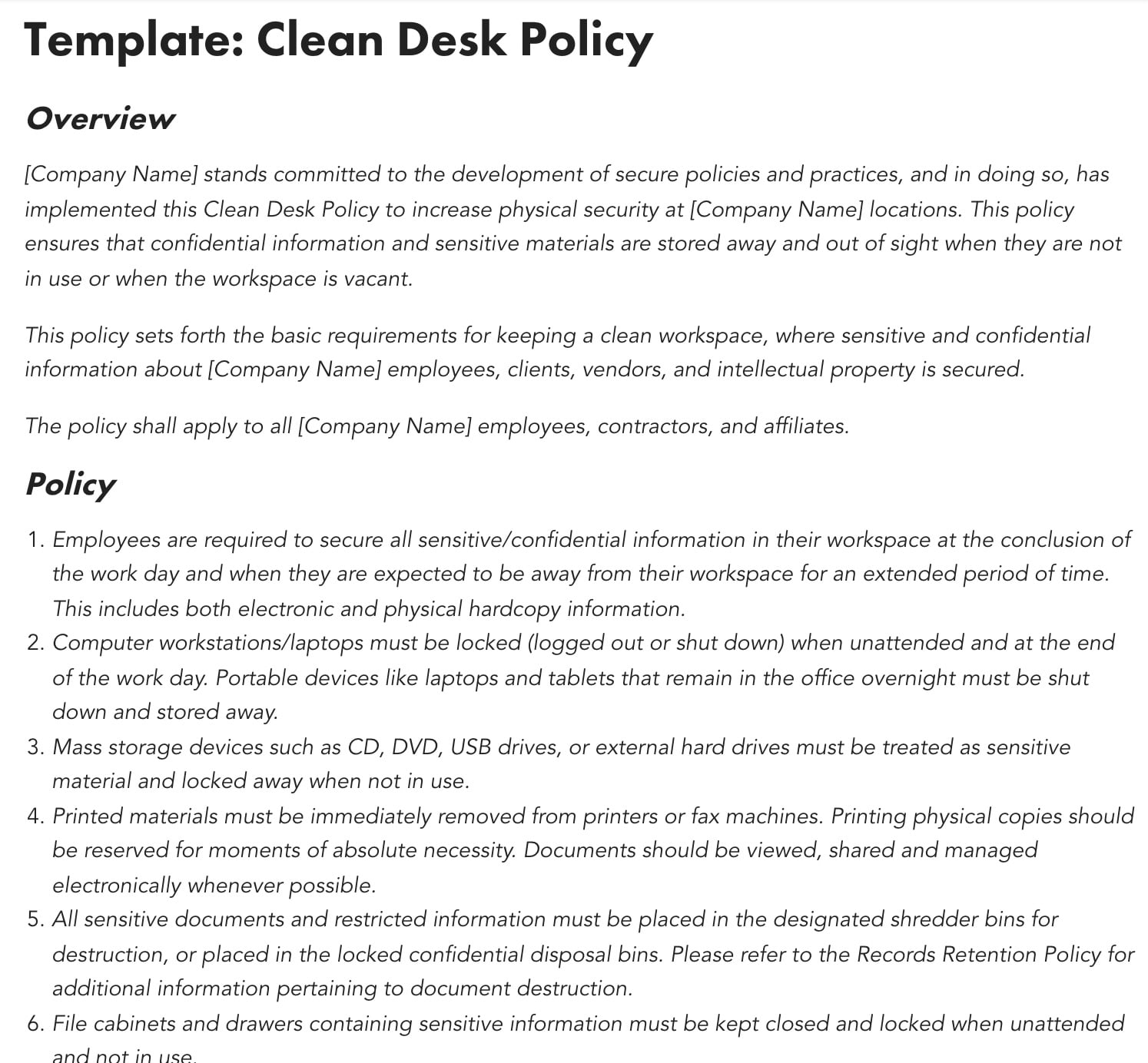
Social media acceptable use policy template
A social media policy template breaks down the appropriate use of social media in a company. It’s designed to protect your company’s brand, data, and privacy. The policy delineates what’s okay and not okay when posting on social media.
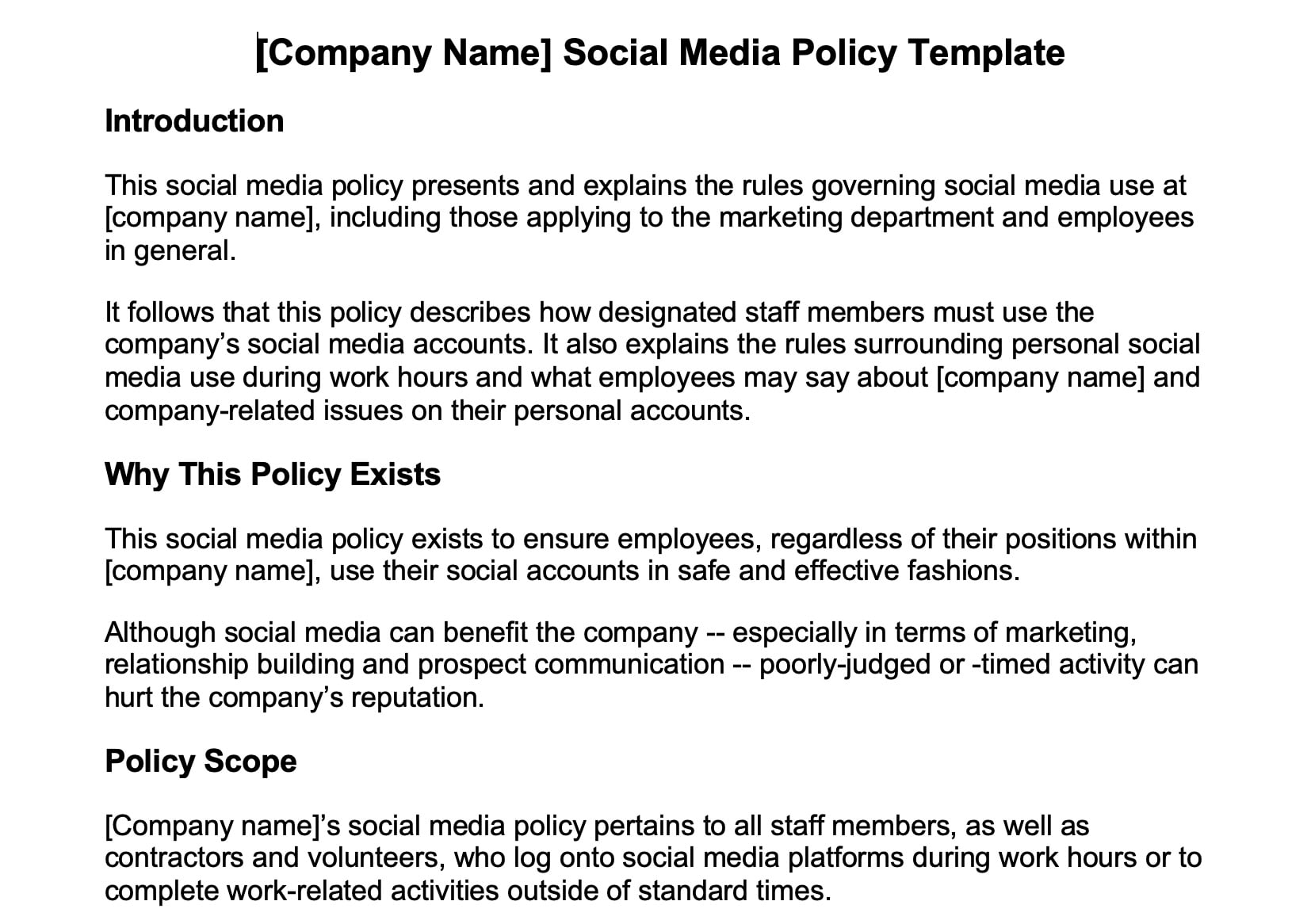
Remote work policy template
As remote work becomes increasingly common, employers have to adjust their IT policies to protect company data. A remote work policy defines a company’s rules for remote work, which is important due to the increased risks present due to employees accessing confidential information outside of the office. Elements of a remote work policy could include requiring employees to use a company computer or a virtual private network (VPN) to increase security measures.
Confidential information policy templates
These are similar to data protection policies. Employees of a company are bound to get their hands on sensitive company, individual, or client information. These policies ensure that employees handle this information confidentially.
These templates often cite legal repercussions if an employee should mishandle or leak confidential information.
monday.com’s IT policy template
monday.com’s IT policy template clearly outlines how to implement IT policies in your organization. No more wondering how to draft guidelines and regulations — any business can easily adopt our policy templates in a plug-and-play manner.
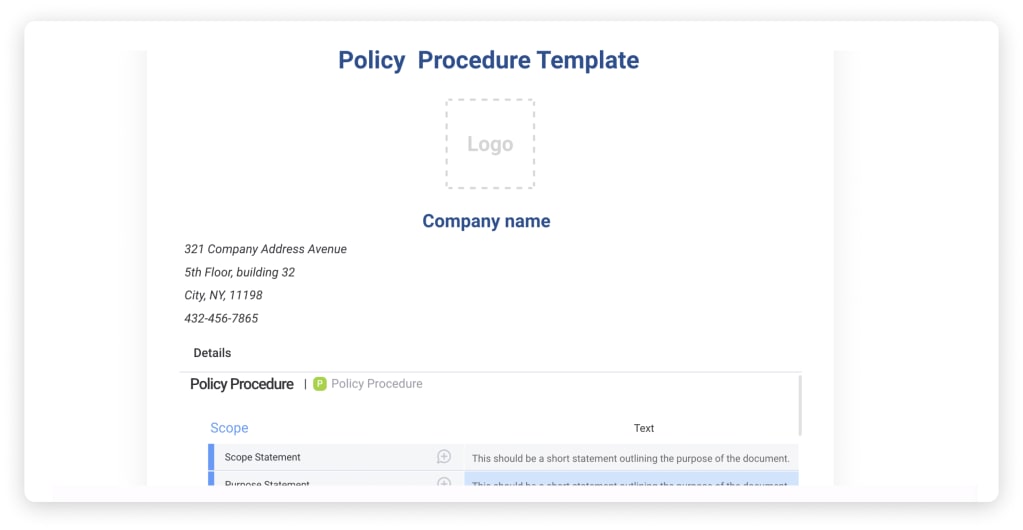
Our template can be used as a part of your knowledge management efforts, making it easy to share IT policies with the whole company. It also makes collaborating on a document easy. If any updates are made to a policy, everyone in your organization can receive a notification pop-up in real-time. This guarantees that all employees remain up-to-date in case there are new changes.
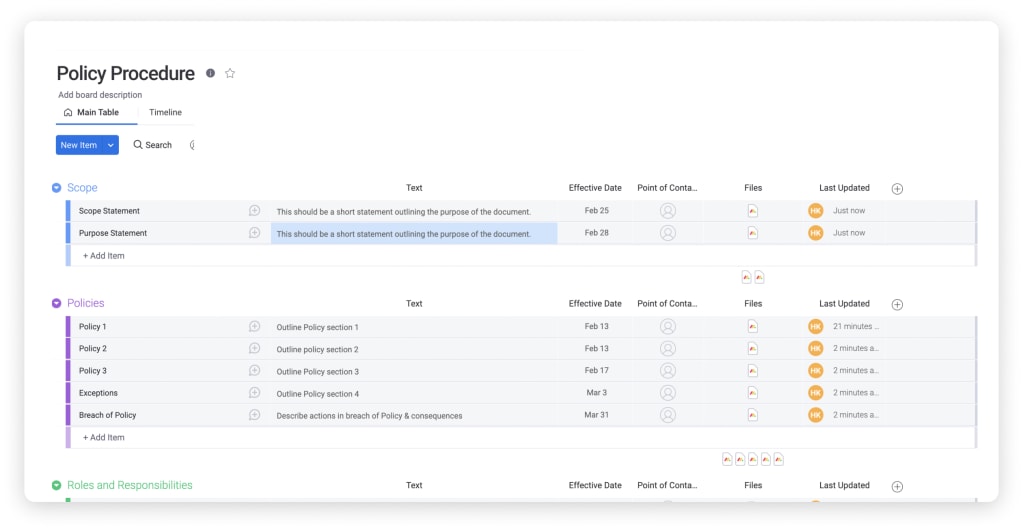
Navigating the template is intuitive. This is especially helpful when employees need to review policies from time to time. It’s also important to archive older versions of your IT policy to prevent your knowledge center from overcrowding. monday.com makes archiving a breeze, so your knowledge space looks clean and organized.
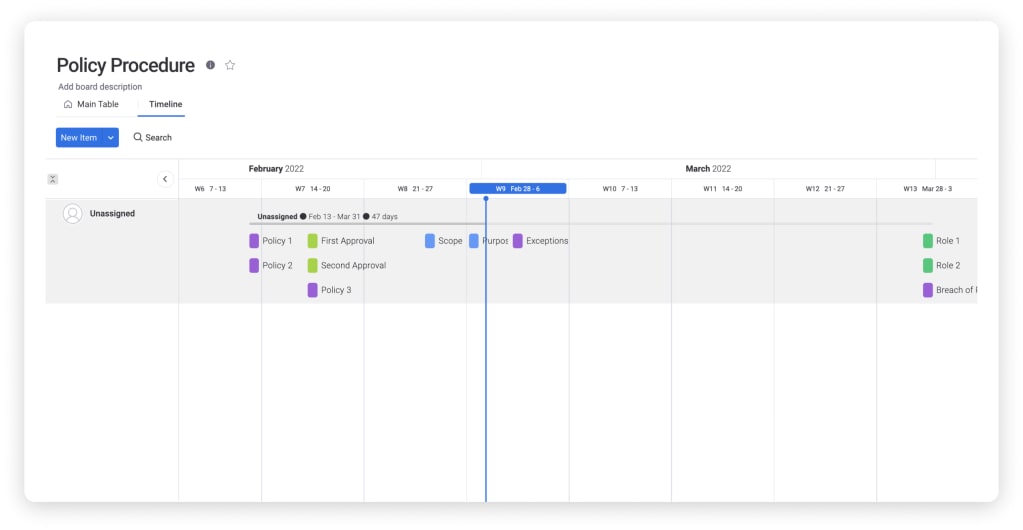
IT template policy tips and tricks
Now that you have the template, it’s time to learn how to get the most out of it.
The right IT policy template can help you and your employees become partners in keeping confidential data safe and avoiding hacks, downtime, and other disasters — but it has no effect if nobody follows the rules.monday.com follows strict security compliances and guidelines, further ensuring that your data is secure.
So here are some tips to successfully implement IT policies in your company.
1. Consult all relevant stakeholders in the company
Before implementing a policy, you should consult all relevant policy stakeholders in the company. For example, while drafting an acceptable use policy for social media, the marketing manager, IT head, and social media manager should collaborate before finalizing it.
2. Make sure the policy fits your business
While our templates can be directly implemented into your business, you may also want to make sure that the policy adapts well to your organization. If it doesn’t, tweak the policy as you see fit.
3. Ensure company-wide adoption
Having an IT policy in place is just the beginning — you also need to implement it across the company. This can be done by sharing the policies with all employees and making them readily accessible.
Once shared, it’s important to train employees in these policies through in-person training or online courses. Managers and supervisors should be tasked with discussing these policies with employees in team meetings to ensure accountability is kept throughout the company.
4. Enforcement of policy
Drafting a policy is just the start — you need to make sure everyone is aware of it and follows it. Regular supervision should be carried out throughout the company to enforce these policies. A breach in policy should have an appropriate action taken.
For lighter breaches, a warning is enough, whereas, for more serious breaches, disciplinary action might need to be taken. You can also include some kind of confirmation, like signing a contract or completing a form.
FAQs about IT policy templates
How do you write an IT policy?
To write an IT policy, follow the steps below:
1. Figure out the needs of your organization
To craft an effective policy, it’s important to understand your company’s needs. One of the biggest mistakes you can make when drafting a policy is to create guidelines without understanding how your organization’s business actually works.
2. Standardize the policy format by using a template
Use a template to minimize inconsistencies and misunderstandings by ensuring that all IT policies have the same format. It wouldn’t look pretty if different IT policies had different formats, so make sure all formats have a standard, duplicable structure.
3. Include all relevant stakeholders in the process
Outline policies with the help of the entire team — otherwise you risk missing necessary rules and practices to keep your data safe.
4. Review and optimize the policy
Once the policy is done, all relevant stakeholders should review the policy and suggest changes if necessary.
What should a policy look like?
A good policy should be clear and concise so that there’s no room for multiple interpretations. Any employee looking at these guidelines should be able to implement them easily. The rules should be fair and keep the interests of the company and its employees in consideration. When communicating a new IT policy, employees should understand:
- When the policy goes into effect
- How the policy will affect their work
- Consequences if the policy is broken
- Any immediate actions required by the employee


